Also on this page...
• The Horse in the New World: Return of the Native?
History of Domestication
It seems that horses have always been a part of the human experience, and the impact of the earliest domestication of the horse on human society must have been profound. Horses would provide increased mobility, the ability to exploit different landscapes, maintain larger families and increase the range of trade contacts.
Beautiful images of horses appear in the Paleolithic cave art of Europe. The famous Chinese Horses at Lascaux, France date between 17,000 - 15,000 B.P. (years before present). The 1994 discovery of Chauvet-Pont-d'Arc cave revealed 400 paintings and engravings that include horses, cave bears, aurochs, rhinoceros, and negative outlines of human hands, all dating between 32,000 and 30,000 B.P. According to archaeological evidence, horses were hunted along with the other animals depicted on the cave walls.
Domestication can be distinguished from the taming or hunting of an animal due to the fact that it involves ownership and results in a completely different level of human commitment. Fortunately for humans, horses fit into a very small category of animals with the required characteristics for domestication. The social and economic implications of horse taming would have been on a local basis, and would have disappeared with the death of the animals involved, while the consequences of domestication would have spread throughout a whole society.
Archaeological evidence suggests that the horse was first domesticated in the south Russian steppes around 6500 B.P (4500 to 3400 B.C.), and that its use then spread westward. Although more recent genetic studies indicate that domestication may have arisen independently in several sections of Eurasia. It was first thought that the domestication process was gradual, as faunal remains indicate horses were used as a food source. However, bone objects dating to this time period from central and Western Europe are believed to be the cheek pieces from bits; if so making it highly probable that actual riding was an important use of the horse from the start.
The domestication of the horse would revolutionize warfare in a way that no other animal, not elephants or camels, could rival. By the second century B.C. horses were used in war to pull light, two-wheeled chariots that carried a two-man crew. Warriors who had access to horses and chariots therefore enjoyed superiority in battle for nearly five centuries.
After the invention of saddles and stirrups, horses enabled nomadic military cultures, such as the Huns and Mongols, to conquer expansive empires. Horses also allowed for military kingdoms to arise in West Africa. A few dozen horses aided the Spanish conquistadors, leading only a few hundred men, to overthrow the two most populous and advanced New World empires. Relatives of the horses that Cortés and Pizarro rode into the Aztec and Inca empires had formerly been native to the New World 10,000 years prior. Had those horses survived, Montezuma and Atahuallpa might have crushed the conquistadors with their own cavalry charges.
The Horse in the New World: Return of the Native?
When the second voyage of Columbus arrived at Hispaniola on November 22, 1493, both the Old and New Worlds would be forever altered. On 17 ships were 1,200 immigrants and numerous domesticated animals such as cows, pigs, sheep and horses -- all brought along to establish ranch colonies in Santo Domingo and the other islands of the West Indies.
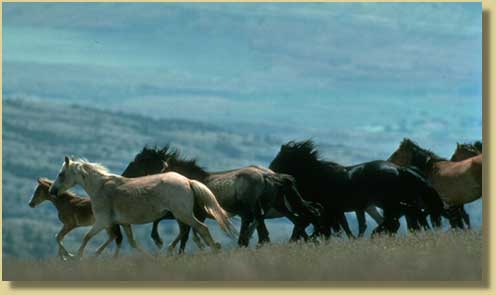
The Pryor Wild Horse Refuge
Hernán Cortés was the first person to land horses on the North American continent. As part of an effort by the Spanish to establish a colony on the mainland of New Spain (Mexico), Cortés landed at Tabasco on March 13, 1519. Arriving with him on their 11 ships were 508 soldiers and, most importantly, 16 horses. Due in part to his ability to build alliances with Native people, the military advantage of the horse, and the fact that Montezuma thought him the incarnate of the Aztec god, Quetzalcoatl, Cortés and his soldiers managed to overthrow the powerful Aztec empire.
Many other Spanish expeditions ventured into the inland territory of New Spain. In 1521, Juan Ponce de León (on his second trip) sailed for Florida with two ships, 200 men and fifty horses landing near Charlotte Harbor. De Soto's explorers had 237 horses on their 1539 trek from Florida to Missouri. In 1540, Francisco Vázquez de Coronado's explorers conduct extensive inland reconnaissance from what is now Mexico and Arizona to Kansas in search of the Seven Golden Cities of Cíbola. They travelled with 248 stallions, the preference of the Spanish military, and two mares.
Although the basis of legends, escaped horses from the early Spanish expeditions were not the seed stock of the wild horse herds of the American West. Only after the mission system in New Spain was established did horses begin to populate North America. Native groups, like the Apache, did raid the missions for horses, and undoubtedly a few horses would have escaped. However, only after the Pueblo Revolt of 1680 could large numbers of wild horses be seen roaming the grasslands of the Plains.
Native Americans and Horses
Toward the year 1600, Spanish horses were introduced to North America and spread northward from the region of New Mexico, reaching almost the entire Plains area by 1750. Native people were exposed to horses at the Spanish missions. Indians were taught how to care for the horses, but they were not allowed to ride or own them. During this time, horses were primarily acquired by raiding the missions. In one foray, a group of Apache was recorded as carrying off 300 head. The Pueblo Indian uprising of 1680 provided a large influx of horses to the Native populations of the Southwest.
Trained Native horsemen acted as the intermediaries in the dispersal of horse culture to other groups through trade and raiding. Horses were first distributed among tribes according to the established trade patterns. Each tribe acquired skills in training horses during the trading process, enabling various groups to utilize the horse quickly.
Word of the horse preceded actual sightings and use among American Indian groups. Tribal histories contain numerous stories of first sightings and initial possession, as well as mythical tales of how the horse came among tribes.
The Southern tribes (Kiowa, Arapaho, Comanche) had horses well before the Northern Plains tribes. Southern tribes brought the horse northward, as is noted in a number of tribal histories. Blackfoot, Salish and Nez Perce oral traditions credit the Shoshones as having first delivered horses to them. Absaroke (Crow) are often cited as having large herds of horses and distributing them to neighboring tribes.
Horses enhanced a preexisting way of life. The horse replaced the dog as the pack animal that pulled the travois, which carried the lodge poles and cover. Due to this factor, the length of the poles and size of the lodges increased. Horses increased the distance that bands could travel and the quantity of goods they could carry, and enabled them to hunt and wage war more successfully. As horses became crucial to Plains life, they became important sources of wealth and prestige.
Wild Horses on the Great Plains
Vast wild horse herds roamed the open ranges of the American West until the mid-1800s, when the westward movement of Euro-American emigrants began. These settlers would permanently alter the physical and cultural landscape of the West.
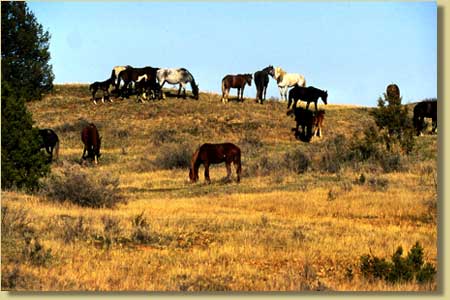
Theodore Roosevelt herd area
The Homestead Act of 1862 provided for the transfer of 160 acres of so-called "unoccupied public land" to each homesteader on payment of a nominal fee after five years of residence. This revolutionary act, along with other means of development such as railroads, barbed wire, roads and cross fences, all became barriers to the migratory routes of wild horses and other animals, as well as the Native peoples of the West.
Escaped domesticated horses, from Euro-American stock, admixed with the Spanish-derived herds and wild horse phenotypes changed with the infusion of new genes. The horses of the American Indian tribes served as a reserve stock from which the wild herds gained new blood.
Initially, the wild horse herds had allowed ranchers to selectively re-supply their stock. However, towards the end of the nineteenth century, the wild horse herds of the Plains retreated to the mountains, canyon lands and deserts. In these areas, which were less desirable for non-Indian settlement, they prospered. Inbreeding and relatively poor nutrition yielded smaller, less attractive animals nicknamed "broomtails" or "jugheads" by unappreciative observers. Cattlemen had mixed views of the wild horse, as either being an icon of the free spirit of the West, or as a nuisance eating the range grass and frequenting the watering holes that the cattle industry depended upon. As wild horse numbers increased in the 1920s the "nuisance" idea would only become stronger.
Evolution of the Cowboy
Columbus brought cattle, along with horses and other domesticated animals, on his second voyage to the New World in 1493. In 1521, Gregorio de Villalobos brought the first cattle from the island colony of Santa Domingo to the mainland of New Spain. He carried seven Spanish Andalusian calves, six heifers and one young bull.
After the conquest of Mexico in the 16th century, the encomienda system was established. A Native village would be given to a Spaniard, the encomendero, who had served his country well. He received the tribute of the Indians, as well as their free labor. In return, the Natives were cared for by the encomendero, and were converted to Christianity. It was hoped that the Indians would be more easily accultured and controlled with this system. In fact, serfdom and the degradation of the Indians became the rule, and attempts were made to end the system.
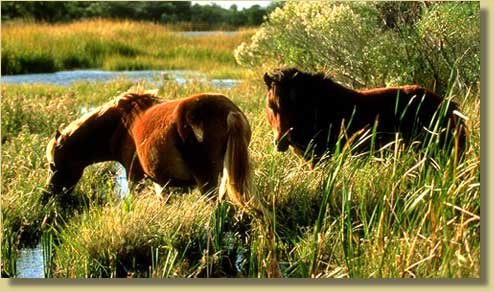
Assateague State Park
Agriculture and ranching were, of course, essential to the survival of the colony. Numerous haciendas developed in the northern part of New Spain (what would become Mexico, Texas, New Mexico, Arizona and California) due to the availability of land that was otherwise useless for cultivation. At the same time, missions were established as far north as San Francisco, where horses, cattle and sheep were also raised. As with horses, some of the cattle and hogs escaped and became wild. There were vast numbers of razorback hogs and longhorn cattle on the prairies. The Indians on the missions and haciendas were taught how to care for the horses and other animals.
By 1750, the Mexican Indians had been taught to ride horses and tend cattle, and had been endowed with all the accoutrements of the Spanish horsemen. These were the original cowboys in North America, the vaqueros. They wore tooled leather chaparahos to protect their legs from the mesquite and cactus, and spurs to coax their horses. Wide-brimmed sombreros protected their eyes from the sun, and they used an ancient design of high-pommeled and cantled saddles. They carried a rope or la reata to catch the cattle.
The free-ranging herds multiplied quickly, and were branded and regulated. Cattle herds numbering 150,000 were reported by travellers in the northern territory. Sheep were also raised in very large numbers, as the more expensive mutton was the preferred meat among the Spaniards. Stockmen had their own guild, the Mesta, which regulated the yearly migration of flocks and herds and allowed ranchers special grazing privileges. In the dry season the animals were migrated to better grass, and later, during the annual rodeo they were rounded up and separated according to brands. Settlers from the United States moving to Texas around 1820 encountered the vaquero and would soon master his skills in the use of the lariat, saddle, spurs and branding iron.
Spirituality and Beauty, Myth and Reality
American author J. Frank Dobie gave wild horses the appellation "wind drinkers," describing them as "... the most beautiful, the most spirited and the most inspiring creature ever to print foot on the grasses of America." Perhaps no wild animal has exemplified spirituality and beauty, to so many, with quite the same style as the horse. With an ancestry in North America extending back to the original "dawn horse" of the Eocene Epoch, the horse has been called "America's gift to the world..." in both myth and reality.
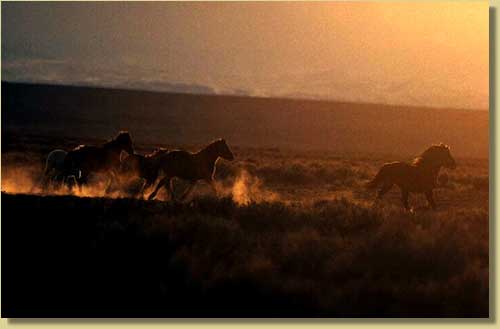
McCullough Peaks herd area
For centuries, humans have drawn pictographs or etched petroglyphs of horses on the walls of caves and surfaces of cliffs. Scribes, poets, sculptors, photographers, and artists have celebrated the horse on the printed page, in stone and bronze, on film and canvas. Few animals have such ancient and intimate connections with mankind. The mystique of horses extends far beyond their external service to humans, as companions in work, in war, in play, in the sheer pleasure of daily association. The horse/human bond has endured through time, transcending domestication and use as a beast of burden. It is a natural affinity that bespeaks of mutual affection between unlike bodies but similar souls.
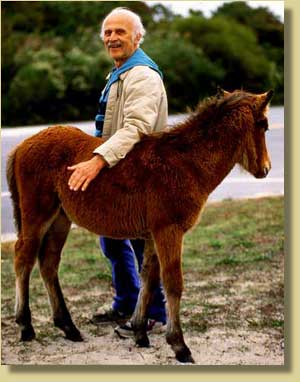
Assateague State Park
When it became clear that America's wild horses were diminishing at an alarming rate, a nationwide outcry for protective legislation brought two bills into the halls of Congress, in 1959 and 1971, both promulgated into law. Hope Ryden, author of America's Last Wild Horses, wrote in 1969: "When I first saw wild horses sweeping across a mountain slope, tails and manes streaming, screaming with an exuberance never heard in any pasture, my whole view of modern America brightened... It was then I decided to learn about them and do everything in my power to keep them alive and free." Through the efforts of Ryden, Velma B. Johnson ("Wild Horse Annie"), other wild horse advocates and humane organizations, combined with an inspired public, the Wild Free-Roaming Horses and Burros Act was passed, in 1971, giving full legal protection to wild horses on lands owned by the Bureau of Land Management and U.S. Forest Service. Its preamble reads:
Congress finds and declares that wild free-roaming horses and burros are living symbols of the historic and pioneer spirit of the West; that they contribute to the diversity of life forms within the Nation and enrich the lives of the American people; and that these horses and burros are fast disappearing from the American scene. It is the policy of Congress that wild free-roaming horses and burros shall be protected from capture, branding, harassment, or death; and to accomplish this they are to be considered in the area where presently found, as an integral part of the natural system of the public lands. (U.S. Code Title 16, Chapter 30, Section 1331)
As "...living symbols of the historic and pioneer spirit of the West..." wild free-roaming horses are recognized as part and parcel of the western American landscape, and its heritage of independence and freedom. Also implied in this description is the spiritual and pragmatic relationship of the Western Euro-American pioneer man and woman to wild free-roaming horses. While vast wild horse herds greeted mountainmen and, later, settlers, a blending of domesticated horses and wild herds slowly took place and etched a lasting place in history for wild horses on the Great Plains.
With flowing tail, and flying mane,
Wide nostrils never stretch'd by pain,
Mouths bloodless to the bit and rein,
And feet that iron never shod,
And flanks unscarr'd by spur and rod,
A thousand horse, the wild, the free,
Like waves that follow o'er the free,
Came thickly thundering on...
They stop, they start, they snuff the air,
Gallop a moment here and there,
Approach, retire, wheel round and round,
Then plunging back with sudden bound,
Headed by one black mighty steed,
Who seem'd the patriarch of his breed,
Without a single speck of hair
Of white upon his shaggy hide;
They snort, they foam, neigh, swerve aside,
And backward to the forest fly,
By instinct, from a human eye.
-- Excerpt from "Mazepra" by Lord Byron
Ironically, the North American wild horse, descended from domesticated stock, has become the ultimate symbol of "wildness" to many Americans. While horses evolved in North America, over a 57-million year period, they became extinct in the late-Pleistocene Epoch between 13,000 and 11,000 years ago. However, their images were painted on the walls of caves (Chauvet cave in France, for example) or carved in ivory (Vogelherd) at least 30,000 years ago. Cro-Magnon peoples readily used the horse as a motif in their paintings, sculptures, and implements. While domestication of the horse is usually considered to have begun in the Ukraine, about 6,000 years ago, a rock engraving of what appears to be a haltered horse has been found in La Marache in France, dating from the Magdalenian period (11,000-17,000 B.P.). Horses were reintroduced in North America on Columbus' second voyage in 1494 and, from breeding farms in the Caribbean, eventually spread onto the Great Plains.
Domestication and an affinity for humans resulted largely from evolved traits within the horse, such as adaptability, intelligence, sociability, curiosity, and a capacity to be submissive, which encouraged them into contact with humans. Unlike many large, hoofed herbivores, they do not possess horns or antlers -- potentially dangerous projections. Horses are, therefore, rounded and soft, with large, beautiful eyes, flowing manes and tails, and -- most frequently -- an aura of devotion to their human associates. Their delicate movements, grace and beauty, and affinity for mankind, have made both wild and domesticated horses icons of spirituality, with a value that far transcends utilitarianism in the American mind.
Characteristics - back to top
There are three main traits that predispose a species to domestication. A horse fits all three. First, the animal typically must be a social species. A herd's subordinate individuals are submissive toward dominant members of the herd, and they can transfer that behavior towards humans. For example, Asian mouflon sheep (ancestors of domestic sheep) have such submissive behavior, but North American bighorn sheep do not - preventing their domestication by American Indians.
Second, a species must be tolerant to intruders and non-territorial. Species, such as deer and pronghorn that flee at the first sign of danger are too nervous to managed by humans. Only reindeer/caribou (Rangifer) among the world's 30 deer species, have been successfully domesticated.
Finally, domestication requires that the species be bred in captivity. The horse is especially interesting in illustrating what seemingly slight differences make one species prized, and another useless. Five of the eight wild horse species have never been domesticated. One wild horse relative, the onager (Equus hemionus onager) of Western Asia, was used to pull wagons for centuries after 3000 B.C. But all accounts of the onagers describe its disposition as "unapproachable" and "bad-tempered." Onagers had to be muzzled to prevent them from biting their attendants. When domesticated horses reached the Middle East around 2300 B.C., onagers were no longer used, and were seen as a failed attempt at domestication. 1
Second Century - back to top
Lying on the grassy Siberian Ukok Plateau among the Altay Mountains, the icy 2,400-year-old kurgan (burial mound) of a woman of the ancient Pazyryk horse culture reflects the high status in her society, as well as that of the horse. She was buried with six of her elaborately harnessed horses. Having been dispatched with a battle-ax, the horses would remain as close to her in death as they had in life. This culture of horsemen and shepards thrived in the mountains and grasslands of the Siberian steppe from the sixth to the second centuries B.C. The importance of horses to the Pazyryk was immeasurable. They were highly valued trade items in exchange for silks, spices and other trade goods in such distant lands as India. The Pazyryks could not survive without their horses - either in this world or, they believed, in the next. As warriors and shepherds, the Pazyryks relied on horses for their semi-nomadic lifestyle. 2
Five Centuries - back to top
The year 700 B.C. roughly marked a turning point in the use of the horse. Chariotry declined rapidly as riding improved and mounted troops increased. The chariot was used only as a parade vehicle and for racing, first in Greek games, and later in the Roman arenas. Hunting was now done on horseback instead of in a chariot. As riders were still without saddles or stirrups, the braking power of a rider was limited, and the types of bits used became rather severe. The bits were often studded, but studs that had been used on the cheek pieces with chariots were now abandoned, since directional control is more easily obtained on a ridden than on a driven horse. 3
Saddles - back to top
The Greek, Roman and Persian saddle was a simple pad laid on a horse's back, secured by a girth and perhaps with a breastplate and crupper. The weight of the rider was distributed across the width of the horses back, including the spine, placing pressure on the horse and causing sores, unless the horse had a sway back. The Scythian saddle consisted of two cushions two feet long, stuffed with deer hair and resting on a saddlecloth, one lying on either side of the spine; relieving pressure and allowing for longer riding.
The similarity of saddles and bridles seen on the "terracotta army" cavalry horses found in the burial tomb of the first Chinese Emperor, Qin Shi Huang, and of those found in Pazyryk burials demonstrates the Chinese debt to the mounted tribes of the Eurasian steppes. The Chinese not only adapted the technology of riding astride, but also the riding gear that made this practical -- the saddle and stirrup.
Stirrups - back to top
It is thought that the first true stirrup was developed not to increase the stability of the rider, but to provide an easier and safer method for mounting the horse. Without stirrups, mounting a large or restive horse is difficult and even hazardous for a small or inactive rider. According to Chenevix-Trench, prior to invention of the mounting stirrup, an elderly or "dignified horseman had to resort to a mounting-block, or the back of a kneeling slave." 4 The mounting stirrup did not come in pairs, and was attached to only one side of the saddle. The earliest documented example of a mounting stirrup was discovered on a pottery figure of a cavalryman in a Western Jin dynasty (265-316) tomb dating from 302 near Changsha, China.
A horse can gallop better if the rider stands in the stirrups than if sitting down in the saddle, also making it possible to ride further and faster. The earliest depiction of a pair of riding stirrups was discovered on a pottery horse at a tomb near Nanjing, China dating from 322. The stirrups shown on the Nanjing horse were triangular in shape and provide the world's first known representation of a pair of riding stirrups. The first actual stirrup was discovered in a Xianbei site near Anyang, China in 1974. This was a single stirrup thought to date from the fourth century. 5
For a nomadic army, such as the Huns, the tactical effects of stirrups were just as relevant. The invention of the stirrup meant that for the first time mounted cavalry had a secure platform from which to fight. British authority Charles Chenevix-Trench feels that the best defensive tactic for an archer would have been to canter or gallop parallel to the enemy's front, shooting into the adversary a stream of arrows at more or less the same range, while also being a difficult moving target. Meaning that these archers had to ride short in the saddle and stood in their stirrups to shoot. 6 From the fourth century onward, the stirrup had spread to North China, northeast Asia, farther south into Korea, and even into Japan. In all of these locations, stirrups were oval and flat, and with a rather long handle, with either a wooden core covered by gilded bronze or iron plate or forged entirely from bronze or iron.
Huns - back to top
The Huns were a nomadic, pastoralist people who invaded southeastern Europe c. 370 A.D. and over the next seven decades built up an enormous empire there and in central Europe. Their brilliant leader, Attila, was known throughout history as FLAGELLUM DEI (LATIN: SCOURGE OF GOD); commanding one of the greatest mounted armies in history. He was king of the Huns from 434 to 453, ruling jointly with his elder brother Bleda until 445. Attila murdered his brother that year, thereafter ruling the Huns as an autocrat. 7
Attila was one of the greatest of the barbarian rulers who assailed the Roman Empire, invading the southern Balkan provinces and Greece and then Gaul and Italy. In legend he appears under the name Etzel in the Nibelungenlied and under the name Atli in Icelandic sagas. His great reputation commanded tributes of more than a ton of gold a year from the Romans - insurance that the Huns would not attack Roman territories. When the Romans neglected to pay the tribute, Attila unleashed his wrath. In his twenty years of power, Atilla was defeated only once. 8
The Huns were a people of mystery and terror to the early medieval world. Arriving on the fringes of the flailing Roman Empire in the late fourth century, riding their war horses out of the great steppes of Asia, they struck fear into Germanic barbarians and Romans alike. It is thought that they had earlier moved against the Chinese Empire but were turned away and swept towards Rome instead. As they approached the Black Sea and conquered the Ostrogoths, the Huns also drove the Visigoths across the Danube into the Roman Empire and caused the crisis that led to the astounding defeat of the Roman army under the Emperor Valens at Adrianople in 378 AD. 9
F o o t n o t e s
1. Diamond, Jared. "The Accidental Conqueror." Dec. 1989. Discover Publications. http://sks5.sirs.com/cgi-bin (11 Jan. 2001)
2. Polosmak, Natalya. "A Mummy Unearthed From the Pastures of Heaven", 1994, National Geographic, 186(4), pp. 80-103.
3. "The Legacy of the Horse: A Chronological History of Humans and Their Relationship With the Horse: The Classical World, 700 B.C." The International Museum of the Horse. http://www.imh.org/imh/kyhpl1c.html (16 Feb. 2001).
4. Chenevix-Trench, Charles. A History of Horsemanship. (New York: Doubleday & Co., Inc. 1970), p. 65.
5. "The Legacy of the Horse: A Chronological History of Humans and Their Relationship With the Horse: The Oriental Horse." The International Museum of the Horse. (21 Feb. 2001)
6. Chenevix-Trench, Charles. A History of Horsemanship. Garden City, New York: Doubleday & Co., Inc. 1970. p. 66.
7. "Attila" Encyclopaedia Britannica Online. http://search.eb.com (23 Jan. 2001)
8. Ibid.
9. Etzel, Diether. "The Huns." I'm a Barbarian. http://art1.candor.com/barbarian/attila.htm (22 Feb. 2001)